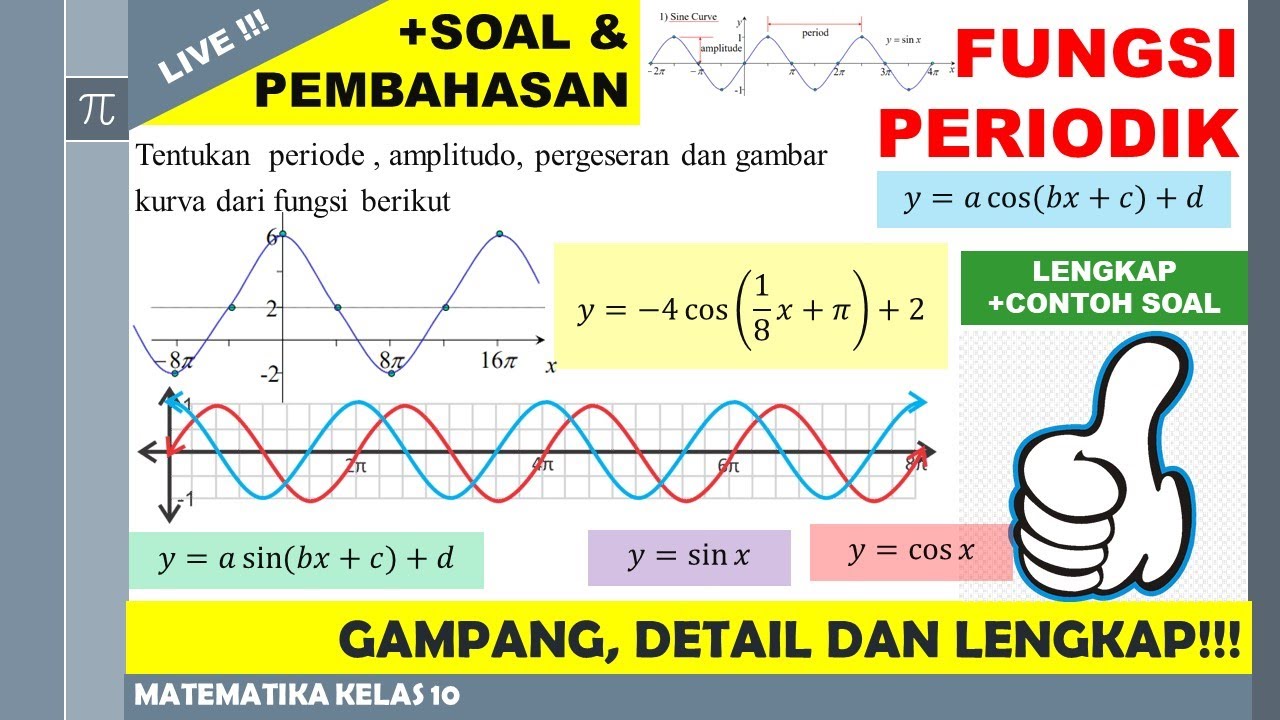Funções Periódicas - Seno - Cosseno - Tangente | Prof. Fernão
Summary
TLDRIn this lesson, the focus is on periodic functions, specifically trigonometric functions like sine, cosine, and tangent. The concept of periodicity is explained through real-life examples, such as surfing and wave patterns, where the 'period' refers to the time between consecutive waves. Key concepts covered include amplitude, period, and the importance of these properties in understanding periodic behavior. The video also introduces the graphical representation of periodic functions, emphasizing the role of the mean line, amplitude, and how these concepts are foundational in further studies of trigonometry.
Takeaways
- 😀 The class focuses on periodic functions, specifically sine, cosine, and tangent, and their application in physics (e.g., simple harmonic motion and pendulums).
- 😀 The concept of a 'period' is introduced through the example of a surfer waiting for waves, where the period is the time between consecutive waves.
- 😀 A wave's period is typically measured in seconds, and it is the time between the arrival of one wave and the next.
- 😀 The 'amplitude' of a wave is its height, measured from the middle (mean line) of the wave to the peak or trough.
- 😀 The height of a wave is measured from the middle of the wave to either the peak or trough, not from the beach level.
- 😀 Amplitude is important for surfers, as it represents the intensity of the wave's vertical displacement.
- 😀 The 'mean line' is the baseline level, typically representing the average position, and is central to understanding wave behavior and periodic functions.
- 😀 The concept of periodic functions is demonstrated with waves and how they repeat after each period, just like waves coming in a consistent sequence.
- 😀 A periodic function repeats its values at regular intervals, and the distance between equivalent points in the function is known as the period.
- 😀 The period of a function can be seen as the smallest interval after which the function starts repeating itself.
- 😀 The function is considered periodic when it satisfies the equation f(x) = f(x + P), where P is the period, and it is a positive value indicating regular repetition.
Q & A
What are periodic functions in the context of this lesson?
-Periodic functions are those that repeat their values at regular intervals. In this lesson, the focus is on periodic functions in trigonometry, such as sine, cosine, and tangent functions, which have specific periods and amplitudes.
How is the concept of 'period' explained in the context of surfing?
-The period in surfing refers to the time between the arrival of two successive waves in a series. This is the time interval between one wave passing and the next, often measured in seconds.
Why is the concept of 'amplitude' important for a surfer?
-Amplitude refers to the height of a wave, measured from the middle of the wave (the mean line) to its peak. Surfers need to understand amplitude to gauge how high they will be on the wave and prepare accordingly for the ride.
What happens if a surfer does not position themselves correctly in relation to the wave's amplitude?
-If a surfer does not position themselves correctly, they may experience a significant fall because the water level lowers as the wave retreats. The surfer might not be able to ride the wave properly, resulting in a more difficult or even dangerous experience.
What does the 'mean line' represent in a wave?
-The 'mean line' represents the middle or baseline of the wave. It's the reference point from which the amplitude is measured both upwards and downwards.
How can the amplitude be measured?
-Amplitude is measured as the vertical distance from the mean line to the highest or lowest point of the wave. It is typically considered from the midpoint of the wave to the crest or trough.
How do periodic functions relate to real-life examples like surfing?
-Periodic functions, like the ones described for waves, help to model and understand real-world cyclical phenomena, such as the movement of waves in the ocean. These functions have repeating intervals (periods) and consistent amplitudes, similar to how waves behave.
What is the significance of the function's period in terms of time?
-The period of a function is the time it takes for a wave to complete one full cycle, after which the values repeat. For example, in the context of waves, the period is the time from one wave's crest to the next.
What are the differences between the period and the amplitude of a periodic function?
-The period refers to the time between one complete cycle and the next, while the amplitude is the height of the wave from its mean line to its peak. Both are crucial in understanding the wave’s behavior.
What is meant by a 'function's image' in the context of periodic functions?
-The image of a function refers to the set of output values (y-values) that correspond to specific input values (x-values). In periodic functions, this image is confined within a specific range, which is defined by the amplitude of the wave.
Outlines

This section is available to paid users only. Please upgrade to access this part.
Upgrade NowMindmap

This section is available to paid users only. Please upgrade to access this part.
Upgrade NowKeywords

This section is available to paid users only. Please upgrade to access this part.
Upgrade NowHighlights

This section is available to paid users only. Please upgrade to access this part.
Upgrade NowTranscripts

This section is available to paid users only. Please upgrade to access this part.
Upgrade NowBrowse More Related Video

Pengertian, Jenis, dan Grafik Fungsi Trigonometri (Matematika Peminatan Kelas XI BAB I Part I)

Fungsi 12: Fungsi Periodik dan Grafik Fungsi Trigonometri Kelas 10

Pre-Calculus 12 - Video #32: Trigonometric Equations

ECUACIONES TRIGONOMETRICAS

Media Pembelajaran Trigonometri || Jari Trigonometri (Jargonometri)

Tanda Fungsi Trigonometri Tiap Kuadran | Matematika Tingkat Lanjut SMA Kelas XI Kurikulum Merdeka
5.0 / 5 (0 votes)